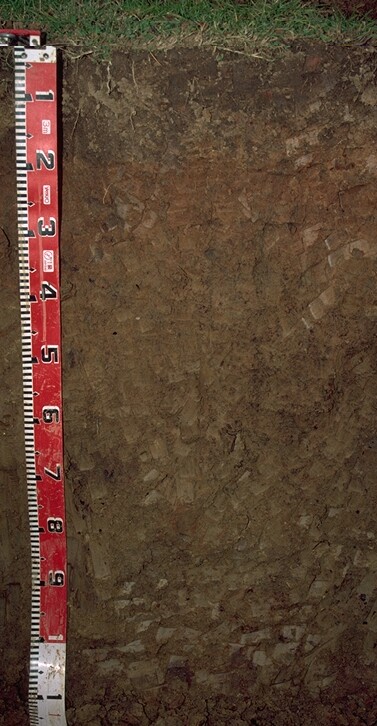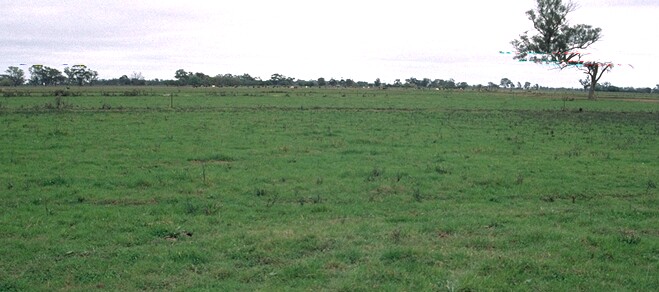GN31
Location: Mooroopna North
Australian Soil Classification: Vertic (and Hypocalcic), Mottled-Hypernatric, Red SODOSOL
Northcote Factual Key: Dr 3.13
Great Soil Group: red-brown earth
Soil Type: Lemnos Loam
General Landscape Description: Level plain with prior stream activity. This site has been irrigated with saline-sodic wastewater reuse.
| ||
Surface Soil
| A1 | 0-20 cm | Brown (10YR4/3) clay loam; weak to moderate coarse blocky structure, firm consistence moist; pH 9.0; abrupt and wavy change to: |  GN31 Profile |
| Subsoil | |||
| B21 | 20-35 cm | Red (2.5YR4/8) [with yellowish brown (10YR5/4) associated with root channels] medium heavy clay; moderate very coarse blocky structure; very firm consistence moist; pH 8.9; gradual change to: | |
| B22 | 35-80 cm | Yellowish brown (10YR5/4) with faint reddish yellow (5YR6/6) mottles; medium heavy clay; very firm consistence moist; contains a slight (10 %) amount of manganiferous nodules (2-5 mm | |
| B23 | 80-110 cm | Yellowish brown (10YR5/4) with faint reddish yellow (5YR6/6) mottles; medium clay; breaks to strong fine polyhedral structure; slickensides present; firm consistence moist; contains a trace (2 %) amount of manganese stains as well as soft carbonate pH 8.3. | |
Key Profile Features:
- Strong texture contrast between surface (A1) horizon and subsoil (B21) horizon.
- Slickensides present in deeper subsoil (ie. vertic).
pH | Salinity Rating | |||
Surface soil (A1 horizon) | Strongly Alkaline | Low | Strongly Sodic | Moderate |
Upper subsoil (B21 horizon) | Strongly Alkaline | Low | Strongly Sodic | Complete |
Deep subsoil (at 1 m) | Strongly Alkaline | Low | Strongly Sodic | Slight-Moderate |

- The surface soil has a high fine sand (28%) and silt (36%) content. Organic matter is important for such soils in order to maintain aggregation. Organic matter levels will build up under pasture but will decline if cultivation takes place. Practices such as residue retention, minimum tillage and including pasture rotations should be included if cropping takes place. As well as improving aggregation, organic matter assists in increasing soil water holding capacity and fertility.
- The surface soil is moderately dispersive (complete dispersion occurs after remoulding). Such a soil is likely to become massive upon drying and surface crusting is likely to occur if bare soil is exposed to disturbance such as raindrop impact or cultivation whilst in a moist to wet condition. Structural degradation will result in problems such as decreased water infiltration, friability and seedling emergence and development of a hard cloddy seedbed. If cultivated too dry it may pulverise (become 'powdery') which will also result in structural degradation.
- The dispersive surface soil is highly erodible to water when exposed to raindrop impact. Maintaining a protective surface cover is important.
- The upper subsoil is strongly sodic and disperses completely. It will swell strongly when wet and become less permeable to water as pores become blocked. Waterlogging is likely to occur after heavy rains. Root and oxygen movement will also be restricted.
- High levels of exchangeable sodium in the subsoil may also result in nutrient imbalances and could even have a toxic effect on some plants.
- The subsoil displays vertic properties (ie. slickensides) which indicates that significant shrinking and swelling occurs during wetting and drying cycles. In soils that have strongly developed vertic properties, there are implications for engineering purposes (eg. building foundations).
Profile described by Mark Imhof and Paul Rampat (5/6/96)


